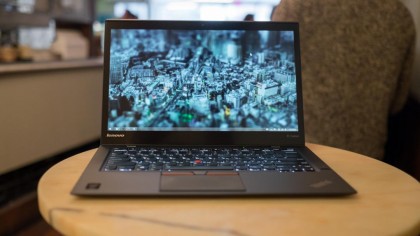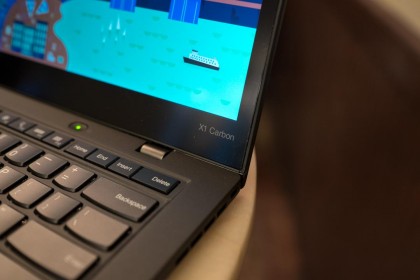TechRadar Verdict
The Lenovo X1 Carbon offers reliable performance with a stellar keyboard, but short battery life and a glare-filled screen are two untenable problems.
Pros
- +
Excellent, reliable performance
- +
The very best keyboard and trackpad
- +
Thin and solid build quality
Cons
- -
Paradoxically glare-prone anti-glare coating
- -
Still no SD card reader
- -
Unimpressive battery life
Why you can trust TechRadar
If the 2014 was the year the Lenovo X1 Carbon went through the sexy makeover, this year the 14-inch business laptop has jumped back into its old suit and tie. The third generation X1 Carbon is just as thin as and sleek as 2014 model, but Lenovo has done away with one of the laptop's most distinctive elements in replacing the row of adaptive, digital function keys with a completely traditional set.
Otherwise, Lenovo has given its latest Ultrabook a by-the-numbers refresh, with faster and more energy-efficient Broadwell processor options. The annual upgrade comes as a bit of a letdown, compared to the massive retooling the 2014 model saw.
That said, Apple is equally guilty of doing the same time and again, like with its 13-inch MacBook Pro. But with laptops like the Dell XPS 13 reshaping Ultrabooks for less scratch to boot, this Lenovo ThinkPad X1 Carbon is easily overshadowed.

Design
If you were to sit the new Lenovo X1 Carbon next to it predecessor, they would look almost like identical twins. That's not really surprising, since the two 14-inch laptops share practically the same frame with a few subtle changes.
Firstly, Lenovo made a few weight saving measures by dropping the carbon-fiber lid for a carbon- and glass-fiber reinforced plastic panel that's still resilient against flexing. Similarly, the new laptop features a hard, semi-glossy finish in place of its predecessor's soft touch feel. As a result, the laptop is a bit plainer (falling in line with the rest of Lenovo's enterprise notebook fleet), but it's less prone to scratching and picking up fingerprints.
Overall, these changes have reduced the weight of the new unit by 0.05 pounds (0.02 kg). Nothing too astonishing, but every ounce matters, and this 3.1-pound (1.4 kg) machine is amazingly light for a 14-inch laptop. What's more, Lenovo hasn't sacrificed anything in the way of rigidity with its latest Ultrabook.

The keyboard still doesn't not exhibit the slightest bit of flex unless you're putting your entire weight on top of the machine. The laptop's base is also still made with the same magnesium-aluminum base, which offers plenty of strength, thanks to a lightweight alloy blend.
One thing Lenovo has improved upon is ratcheting tighter hinges, which prevents the screen from wobbling while you adjust it. Plus, users can still push back the display to an impressive 180-degrees, laying the laptop flat if they so wish. It won't bend back completely back, like Lenovo's Yoga series of notebooks, but the greater degree of freedom will allow for some very relaxed typing positions, if you prefer to kick back while drafting documents.
As for ports, the X1 Carbon has two USB 3.0 ports on tap along with a complement of video ports including HDMI and mini DisplayPort, plus Lenovo's proprietary OneLink connector. Curiously, an SD card reader remains to be a glaring omission. It's not a deal breaker. However, SD cards may be important to users who want to bolster on-board storage and those in creative fields that make heavy use of SD memory. (Though, it's doubtful that the creative crowd is this machine's target audience.)

One step back
The most immediately noticeable difference from last year's model is Lenovo has replaced the row of nifty adaptive keys with a set of standard function keys. Personally, I feel this is a big step back. These function keys would transform in virtual buttons depending on the task at hand, such as navigation controls while in a web browser or Skype would call for a set of video chat-centric commands.
Instead of these transforming keys, you're stuck with a static group of shortcuts to adjust brightness and other basic laptop settings. These are important, of course, but the adaptive function row was one of the few touches that Lenovo added to set the X1 Carbon apart.
The new model is a little less special without this unique feature not found on any other laptop. That said, it's not a stretch to imagine that Lenovo's enterprise audience received the forward-thinking change poorly.
Kevin Lee was a former computing reporter at TechRadar. Kevin is now the SEO Updates Editor at IGN based in New York. He handles all of the best of tech buying guides while also dipping his hand in the entertainment and games evergreen content. Kevin has over eight years of experience in the tech and games publications with previous bylines at Polygon, PC World, and more. Outside of work, Kevin is major movie buff of cult and bad films. He also regularly plays flight & space sim and racing games. IRL he's a fan of archery, axe throwing, and board games.

